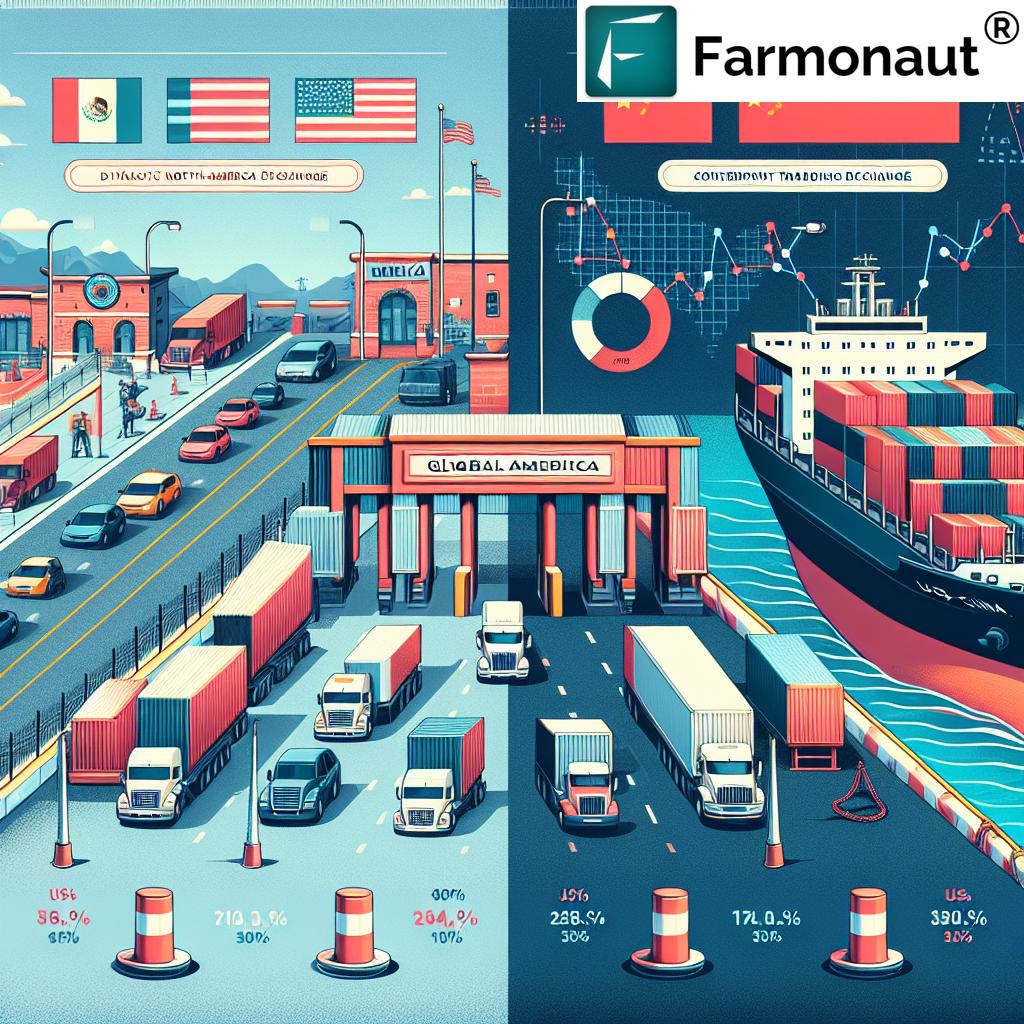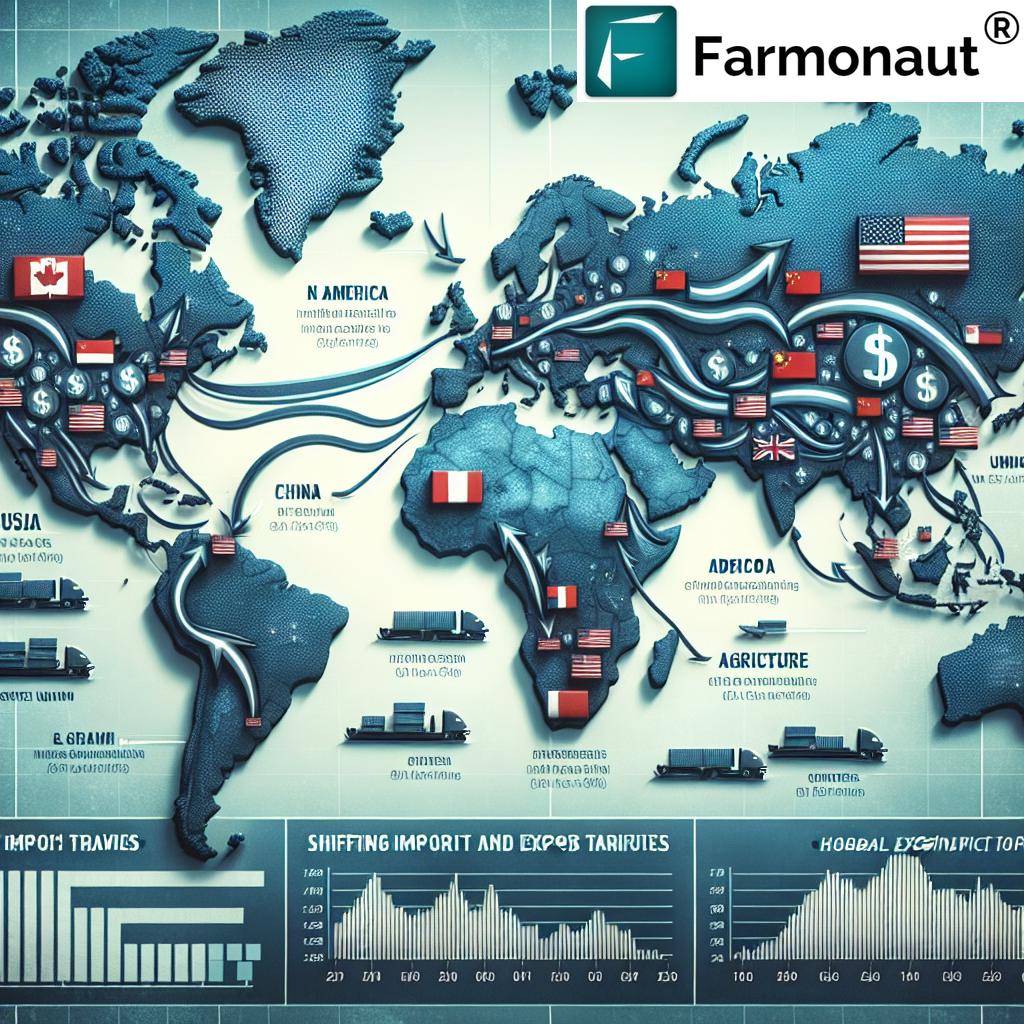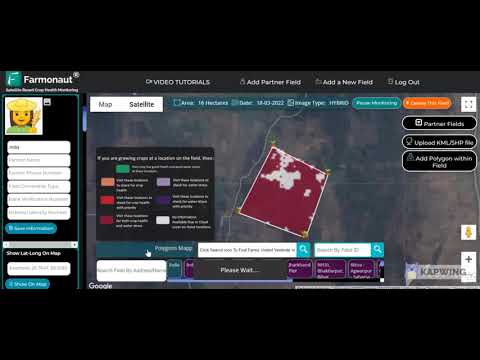Global Trade Tensions: How US Tariffs Impact North American and Chinese Markets
“US tariffs on imports have affected over $500 billion worth of Chinese goods, reshaping global trade dynamics.”
In recent years, we’ve witnessed a seismic shift in the landscape of international trade. The imposition of US trade tariffs has sent shockwaves through global markets, particularly impacting North American and Chinese economies. As experts in agricultural technology and remote sensing, we at Farmonaut have been closely monitoring these developments and their far-reaching consequences on various industries, especially agriculture.
In this comprehensive analysis, we’ll delve into the intricate web of global trade relations, exploring how tariff policies are reshaping international markets and influencing industry trends. Our goal is to provide valuable insights into the shifting landscape of world trade and its implications for businesses and economies worldwide.
The Genesis of Trade Tensions
The current trade tensions find their roots in the America First policy championed by former US President Donald Trump. In a bold move that has continued to reverberate through global markets, substantial tariffs were imposed on imports from Canada, Mexico, and China. These actions have fulfilled a prior threat and marked a critical shift in U.S. trade policy.
- A 10% levy on all Chinese goods
- A substantial 25% tariff on imports from Canada and Mexico
- An additional 10% tax on Canadian energy imports
These tariffs are likely to have far-reaching consequences for both the U.S. economy and its trading partners. Let’s examine the impact on each of these key players in the global trade arena.
Impact on Mexico: A Close Neighbor Caught in the Crossfire
Mexico, the United States’ largest trading partner, stands to face severe repercussions from these tariffs. With over 80% of Mexico’s exports directed to the U.S., many businesses and jobs are at stake. President Claudia Sheinbaum’s swift reaction underscores the gravity of the situation.
- Economy Minister Marcelo Ebrard tasked with developing a countermeasure plan
- Risk of escalating tariff conflict looms large
- Potential for increased inflation and employment issues in both nations
The Trump administration has also linked tariff enforcement to Mexico’s actions regarding issues like migration and drug trafficking. This multifaceted approach adds another layer of complexity to an already tense situation.
Canada: Navigating Choppy Waters in Trade Relations
Canada, with its strong trade ties to the U.S. amounting to nearly a trillion dollars annually, faces significant challenges. Industries in Canada, particularly those involved in agriculture and energy, could suffer significantly due to increased costs and reduced market appeal in the U.S.
- Prime Minister Justin Trudeau has indicated plans to retaliate against American tariffs
- Agriculture and energy sectors bracing for impact
- Potential for a volatile trade relationship between long-standing partners
The impact on Canada’s agricultural sector is particularly concerning, given the importance of cross-border trade in this industry. As agricultural technology experts, we at Farmonaut understand the critical role that stable trade relationships play in ensuring food security and economic stability for farmers.
China: The Dragon in the Trade War
The ongoing tariffs on Chinese goods aim to mitigate what the U.S. administration critiques as illicit drug trafficking, particularly the flow of fentanyl into the U.S. These tariffs place additional strain on China’s already faltering economy.
- Potential for Chinese retaliation through tariffs on U.S. agricultural products
- Possibility of restrictions on rare earth exports
- Escalating tensions could lead to a full-blown trade war
The agricultural sector in both countries stands to lose significantly if this trade war escalates. Chinese imports of U.S. soybeans, for instance, have already seen dramatic fluctuations due to these tensions.
European Implications: Caught in the Crossfire
While not directly targeted by these specific tariffs, European businesses, especially in the automotive sector, are feeling the ripple effects of these trade tensions.
“The automotive industry in Europe faces potential losses of up to €10 billion annually due to US trade tensions.”
- European car manufacturers like Volkswagen and BMW rely heavily on operations in Mexico
- Increased costs associated with exporting from Mexico could lead to production relocation
- Potential for intensified competition from local Chinese brands in the European market
The automotive industry’s challenges highlight the interconnected nature of global trade and how tariffs in one region can have far-reaching consequences across continents.
The Agricultural Sector: A Key Battleground
As experts in agricultural technology, we at Farmonaut are particularly concerned about the impact of these trade tensions on the agricultural sector. Farmers on all sides of these trade disputes are facing unprecedented challenges.
- U.S. farmers grappling with reduced export markets
- Canadian and Mexican agricultural exports facing higher costs
- Chinese retaliation potentially targeting U.S. agricultural products
In these challenging times, precision agriculture tools like those offered by Farmonaut become even more crucial. Our satellite-based farm management solutions can help farmers optimize their resources and make data-driven decisions to navigate these turbulent market conditions.
Energy Sector: Navigating Choppy Waters
The energy sector, particularly in Canada, faces significant challenges due to the new tariffs. The 10% tax on Canadian energy imports could reshape the North American energy market.
- Potential for increased energy costs in the U.S.
- Canadian energy companies may need to seek alternative markets
- Possible shift in global energy trade patterns
These changes in the energy sector could have cascading effects on various industries, including agriculture. At Farmonaut, we understand the importance of efficient resource management in agriculture, and our tools can help farmers adapt to changing energy costs and availability.
Global Economic Impact: A Ripple Effect
The impact of these tariffs extends far beyond the directly involved countries. The global economy is interconnected, and disturbances in major economies can have wide-reaching consequences.
- Potential slowdown in global economic growth
- Disruption of global supply chains
- Increased uncertainty in financial markets
Economists warn of far-reaching consequences on production, exports, and overall economic health. As governments navigate these turbulent waters, businesses must adapt to a rapidly changing economic landscape.
The Role of Technology in Mitigating Trade Tensions
In these challenging times, technology can play a crucial role in helping businesses, especially in the agricultural sector, navigate the complexities of international trade. At Farmonaut, we believe that our advanced, satellite-based farm management solutions can provide valuable support to farmers and agribusinesses affected by these trade tensions.
- Real-time crop health monitoring can help optimize production in uncertain markets
- AI-based advisory systems provide data-driven insights for decision-making
- Blockchain-based traceability can ensure compliance with changing trade regulations
Our platform, accessible through web and mobile apps, allows farmers to track and manage their farms efficiently, helping them adapt to changing market conditions.
Comparative Tariff Impact Analysis
| Affected Sector | Imposing Country | Target Country | Tariff Rate (%) | Estimated Annual Impact ($USD billions) | Retaliatory Measures | Potential Long-term Consequences |
|---|---|---|---|---|---|---|
| Automotive | US | Mexico | 25% | 50 | Tariffs on US agricultural products | Relocation of manufacturing, increased costs for US consumers |
| Agriculture | China | US | 25% | 30 | Restrictions on rare earth exports | Reduced market for US farmers, potential oversupply |
| Energy | US | Canada | 10% | 15 | Tariffs on US manufactured goods | Higher energy costs in US, strained diplomatic relations |
| Steel and Aluminum | US | EU | 25% (steel), 10% (aluminum) | 7.5 | Tariffs on US consumer goods | Increased production costs, potential job losses in both regions |
Future Outlook: Navigating Uncertain Waters
As we look to the future, the path forward remains uncertain. The potential for escalating trade wars looms large, with implications for global economic growth and stability.
- Possibility of further tariff increases if retaliations occur
- Potential for new trade agreements to emerge from current tensions
- Increased focus on domestic production and self-sufficiency in affected countries
In this changing landscape, businesses must remain agile and adaptive. At Farmonaut, we’re committed to providing tools that can help farmers and agribusinesses navigate these challenges effectively.
The Role of Technology in Mitigating Trade Tensions
In these challenging times, technology can play a crucial role in helping businesses, especially in the agricultural sector, navigate the complexities of international trade. Advanced solutions like those offered by Farmonaut can provide valuable support to farmers and agribusinesses affected by these trade tensions.
- Real-time crop health monitoring can help optimize production in uncertain markets
- AI-based advisory systems provide data-driven insights for decision-making
- Blockchain-based traceability can ensure compliance with changing trade regulations
By leveraging these technologies, businesses can better position themselves to weather the storm of trade tensions and emerge stronger on the other side.
Conclusion: Adapting to a New Trade Reality
The current trade tensions between the US, its North American neighbors, and China have ushered in a new era of global trade relations. As we’ve explored in this analysis, the impacts are far-reaching, affecting industries from automotive to agriculture, and energy to manufacturing.
While the challenges are significant, they also present opportunities for innovation and adaptation. At Farmonaut, we believe that technology will play a crucial role in helping businesses navigate these turbulent waters. Our advanced agricultural solutions are just one example of how technology can provide valuable support in uncertain times.
As we move forward, it’s clear that the global trade landscape will continue to evolve. Businesses, governments, and individuals must remain informed and adaptable to thrive in this new reality. By staying abreast of developments, leveraging technology, and fostering international cooperation, we can work towards a more stable and prosperous global trade environment.
FAQs
- How do US tariffs affect global trade?
US tariffs can lead to increased costs for imported goods, potentially disrupting global supply chains and leading to retaliatory measures from other countries. - What sectors are most impacted by these trade tensions?
The automotive, agriculture, and energy sectors are among the most significantly impacted by current trade tensions. - How can businesses adapt to changing trade policies?
Businesses can adapt by diversifying their supply chains, exploring new markets, and leveraging technology to optimize operations and ensure compliance with changing regulations. - What role does technology play in mitigating the effects of trade tensions?
Technology, such as Farmonaut’s agricultural solutions, can help businesses optimize resource use, make data-driven decisions, and ensure compliance with changing trade regulations. - How might these trade tensions evolve in the future?
The future of these trade tensions remains uncertain, with possibilities ranging from escalation to new trade agreements emerging from the current situation.
Earn With Farmonaut: Earn 20% recurring commission with Farmonaut’s affiliate program by sharing your promo code and helping farmers save 10%. Onboard 10 Elite farmers monthly to earn a minimum of $148,000 annually—start now and grow your income!
For more information on how Farmonaut can help your agricultural business navigate these challenging times, visit our web app, download our Android app or iOS app, or explore our API for developers. You can also check out our API Developer Docs for more detailed information.








